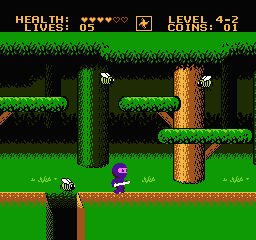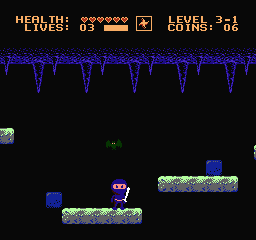Hello.
It’s been a while since I finished my big NES game. While it took me 2 years to complete, it could have been done in 1 year, if I focused on it 100% of the time. The game is still available in a limited release, btw. But enough time has passed to reflect on the development process.
 Purple Cape Man.
Purple Cape Man.My first game I made, “Purple Cape Man, Vigilante Ninja”, was programmed with NESASM. Someone suggested I make a sequel, which became Vigilante Ninja 2, which is entirely unlike the first game in every way.
Vigilante Ninja 2 was programmed with ASM6 (except the music engine, was programmed in cc65/ca65). Graphics were YY-CHR and level design in Tiled (with a custom python script I wrote to compress each level). The design process could have been much better, since it still required lots of cutting and pasting. So, level editing was very slow.
 Vigilante Ninja 2.
Vigilante Ninja 2.What went right?
The music.
Probably the best part of the game. Originally, I wrote a temporary song for the demo, and had planned to write a song for every level. Luckily, estlib was kind enough to write songs for me, which are excellent.
He used more sound effects than any famitone version could handle, so I had to use the full famitracker driver…and again…lucky for me that Shiru wrote a version of famitone to compliment the full famitracker driver.
There is still a small, rare bug that I was unable to diagnose and solve. The main downside to using an unfamiliar sound engine. Occasionally, when you start level 4, the main melody doesn’t play for a few seconds. But the bass line plays. It doesn’t sound “wrong”, but it was.
Some of the graphics.
At the start, I had no idea what I was doing, or even what style I wanted. I actually redid the level 1 graphics 3-4 times, and completely redrew the hero. A fellow homebrewer informed me that the graphics of my game were crap, so I kept trying to improve them.




By the end, especially level 4, I had my flow, and the graphics actually started to click. Many of the enemies in level 5 (fire, ghost) are my favorites.

The process of sketching on paper, and drawing in GIMP, then YY-CHR didn’t change. But, I got better at it over time. I wish I had put more effort into animating. Nearly every enemy only has 2 animation frames. And I had plenty of blank tiles I could have used.
Special thanks again to Nicolas Betoux for drawing the title screen graphics. Paired with the excellent title screen music (by estlib), it really made my little homebrew feel like a real NES game.
The throwing weapons.
One of the more fun parts of the game is collecting different weapons and using them. Oddly, I got complaints that you had unlimited shots, so I (very late) added a power bar, which drains if you use too many weapons. I’m still not satisfied with this hacky solution, since it just slows the game down (especially fighting a boss).
Most of the game engine.
Vigilante Ninja 2 scrolls pretty smoothly, without bugs. The NMI code got a little spaghetti like at the end, when I added bank switching. All the level testing was done with NROM sized roms, even through level 5. I made 2 separate level 5 test ROMs, 1 for level, 1 for boss.
In the end, when I finally switched to MMC3, I put in what I called “trampolines” in the main fixed bank, which switched (for example) the music code and data banks in and started the music engine. But it wasn’t so easy, and the bank switching code is ugly and hacky. But I suppose everything is working… so it’s good enough… just don’t expect to reuse the code in a year and understand what everything is doing.
What didn’t work?
The Sprite system.
I didn’t plan the sprite object system well. Pretty much just used static addresses in the OAM buffer, which made the size and shape of enemies very inflexible and difficult to change. And, I used an entirely different 256 bytes of RAM just for sprite shuffling, which was a huge waste of memory. (NES has only about 2000 bytes of usable RAM).
The worst part of it, was I didn’t use variable names in the original code, just address numbers. And, so much time passed before I revisited the object code, that I barely knew what the numbers meant. I wanted to change things, but I would have had to rewrite a thousand lines of code, so I kept the original terrible system.
I rewrote part of it for the hero, just so I could layer sprites (the sword). I wanted to change the look of coins and make them bigger, but I painted myself into a corner, and couldn’t change a little thing without rewriting everything. So, my biggest regret is not starting with a better sprite code.
The gameplay.
Looking back, there is very little difference between the different sub-levels. Sure, the graphics and enemies change from level to level, but I could have done 100 little things to make each sub-level feel interesting. Hidden things. Changes in graphics. More interactive elements. A specific goal (collect all X, kill all X’s, avoid X). A special throwing weapon only found in room 23. A secret 1 up, if you do X.
Basically, just run from the left to the right, and don’t die. Not great.
Enemy AI.
Probably the weakest point of the game. Most enemies walk left and right. A few fly in right to left. Shoot them, get a standard reward.
Level 3 has the most interesting enemies. The spider can climb any wall, and always follows you. I think (at least in early versions) if you slowly walk right, the spider can climb on top of the ceiling and follow you pretty far.
The bat (not the boss), was an attempt at a more aggressive enemy, who loops around attacking you. However, he’s a bit buggy if you move a certain way. Never quite got him right.

The bees (level 4) chase you, fly just above you, and try to sting you. It’s all timed a certain way, that it pretty much always misses you trying to sting. I had to slow them down, as they were damn hard to get away from or hit.
But, nearly all the rest just slowly walk around, and disappear if they wander just a bit too far left. Also a failure, not keeping off screen coordinates, so he could walk back on screen after that.
The Ending.
I wish I had done a more elaborate ending. It’s just 1 screen of text, and then the credits. I had room for more graphics, I could have done some more graphic story…maybe related to that magic sword I kept talking about.
Marketing.
I really dropped the ball here. I barely made an effort to advertise the game development. I had a thread over at nesdev forums, and mentioned it on my blog. But, almost no one from the nesdev forum asked me for a copy of the game. I guess buyers don’t visit there.
I didn’t make boxes, or print booklets, etc. I could have printed T-shirts. I could have traveled to game conventions. Or tried to contact all the used game stores within an hour drive of my house. But, I didn’t.
When I finally did mention the game to buyers, it was right after the release of Ninja II, a completely different homebrew game with a similar name…which I think caused some confusion.
Actually, the entire concept… making a sequel to a lousy game that no one played, and making it completely different, was confusing. Several people asked me “where is Vigilante Ninja 1?” Well, it’s called ‘Purple Cape Man’, and it’s not the same game. I had a few people ask me, “if he’s a vigilante, why is he fighting squirrels and bunnies?” I think a different name and concept would have helped.
Conclusions…
In 2 years, I learned a lot. Made a full sized NES game. Put it on a cartridge (thanks infinite NES lives), and gamers around the world are playing it. I’ll say partial success. There have been so many great NES homebrew releases lately, that have really raised the bar. Perhaps people would be better off buying Haunted Halloween, or Twin Dragons, or Lizard. I’d be ok with that.
And I’m still making games. Maybe the next game will be the one everyone remembers. Only time will tell. Back to the work I go.
I’m trying to find resources about how to make my own NES game. I’m an engineering student at WWU and I want to learn about the process of making an NES rom and cartridge.
LikeLike
I don’t really go into making the actual cartridge. I paid Infinite NES Lives to make my cartridges. You can buy the raw supplies from them and flash your own ROM chips, but I didn’t.
LikeLike